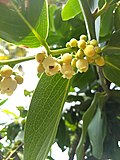Note: This is a project under development. The articles on this wiki are just being initiated and broadly incomplete. You can Help creating new pages.
Diospyros malabarica - Tinduka
The Gaub tree is a species of flowering tree in the family Ebenaceae. It is native to the Indian Subcontinent and South East Asia. It is a long-lived, very slow-growing tree, which can reach up to 35 m in height with a black trunk up to 70 cm in diameter.
Contents
[hide]- 1 Uses
- 2 Parts Used
- 3 Chemical Composition
- 4 Common names
- 5 Properties
- 6 Habit
- 7 Identification
- 8 List of Ayurvedic medicine in which the herb is used
- 9 Where to get the saplings
- 10 Mode of Propagation
- 11 How to plant/cultivate
- 12 Commonly seen growing in areas
- 13 Photo Gallery
- 14 References
- 15 External Links
Uses
Cold, Wounds, Diarrhoea, Dysentery, Blood diseases, Gonorrhoea, Leprosy, Xever, Chronic dysentery
Parts Used
Chemical Composition
Leaves contain triterpenes, betulin, β-sitosterol, oleanolic acid and myricyl alcohol. Bark, flowers and fruits contain tannins[1]
Common names
| Language | Common name |
|---|---|
| Kannada | Holitupare |
| Hindi | Gaab |
| Malayalam | Panancca |
| Tamil | Tumbika |
| Telugu | Bandadamara |
| Marathi | NA |
| Gujarathi | NA |
| Punjabi | NA |
| Kashmiri | NA |
| Sanskrit | |
| English | Indian persimmon |
Properties
Reference: Dravya - Substance, Rasa - Taste, Guna - Qualities, Veerya - Potency, Vipaka - Post-digesion effect, Karma - Pharmacological activity, Prabhava - Therepeutics.
Dravya
Rasa
Guna
Veerya
Vipaka
Karma
Prabhava
Habit
Identification
Leaf
| Kind | Shape | Feature |
|---|---|---|
| Simple | Alternate | Leaves are alternate, simple, oblong, obtuse |
Flower
| Type | Size | Color and composition | Stamen | More information |
|---|---|---|---|---|
| Unisexual | 2-4cm long | Yellow | 5-20 | Flowering time: April-May and Flowers in axillary cymes |
Fruit
| Type | Size | Mass | Appearance | Seeds | More information |
|---|---|---|---|---|---|
| Berries | 7–10 mm | Fruiting time: June-July | many | {{{6}}} |
Other features
List of Ayurvedic medicine in which the herb is used
Where to get the saplings
Mode of Propagation
How to plant/cultivate
A plant of the moist, lowland tropics, where it is found at elevations up to 500 metres. Tt has a very short viability and so should be sown as soon as possible. The flesh should be removed since this contains germination inhibitors.[4]
Commonly seen growing in areas
Lowland rain forests, Along rivers and streams, Shady and wet places.
Photo Gallery
References
External Links
- Ayurvedic Herbs known to be helpful to treat Cold
- Ayurvedic Herbs known to be helpful to treat Wounds
- Ayurvedic Herbs known to be helpful to treat Diarrhoea
- Ayurvedic Herbs known to be helpful to treat Dysentery
- Ayurvedic Herbs known to be helpful to treat Blood diseases
- Ayurvedic Herbs known to be helpful to treat Gonorrhoea
- Ayurvedic Herbs known to be helpful to treat Leprosy
- Ayurvedic Herbs known to be helpful to treat Xever
- Ayurvedic Herbs known to be helpful to treat Chronic dysentery
- Herbs with Fruits used in medicine
- Herbs with Seeds used in medicine
- Herbs with common name in Kannada
- Herbs with common name in Hindi
- Herbs with common name in Malayalam
- Herbs with common name in Tamil
- Herbs with common name in Telugu
- Herbs with common name in English
- Habit - Evergreen tree
- Index of Plants which can be propagated by Seeds
- Index of Plants which can be propagated by Cuttings
- Herbs that are commonly seen in the region of Lowland rain forests
- Herbs that are commonly seen in the region of Along rivers and streams
- Herbs that are commonly seen in the region of Shady and wet places
- Herbs
- Ayurvedic herbs that don't have seed photos
- Ebenaceae





